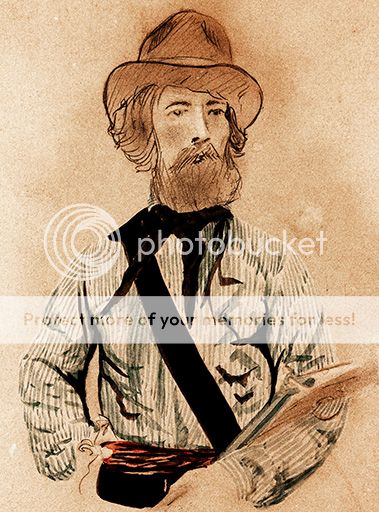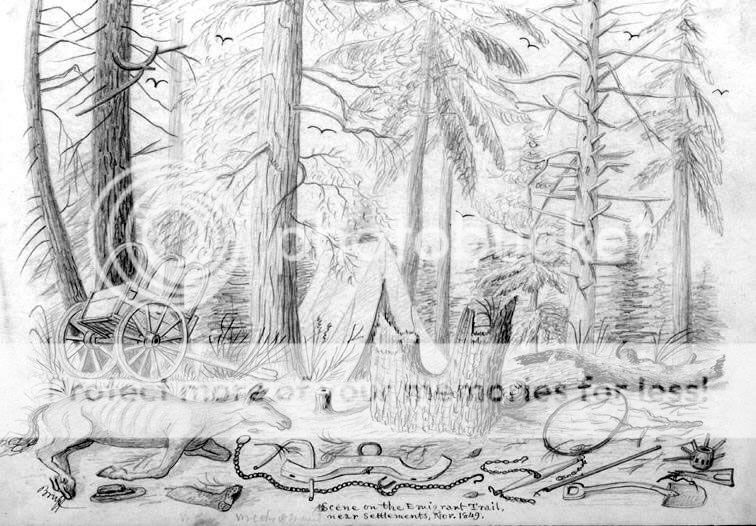
At 44 years of age, Bruff was considerably older than the average "'49er". He was not a man born to the outdoors, but worked as an architectural draftsman in Washington D.C. He had attended West Point from 1820 - 1822, but was expelled for dueling. Although he was a talented artist with a sensitive nature and a soft spot for dogs of all kinds, he possessed tremendous stamina, an indomitable will, and perhaps most importantly, a cheerful optimism which helped him persevere through dire circumstances. When news of gold discovery in California was announced by President James Polk in his inaugural address, January 1949, Bruff decided to join the emigration West. Taking leave from his job and his wife and children for what he believed would be a lucrative venture of eight or nine months duration, he organized and led a party of 66 men to the gold fields, choosing the Oregon-California Trail for the Sierra Nevada crossing.
This route, advocated by Peter Lassen (who had ulterior motives of profiting by selling land to emigrants) was described as a "shortcut" which avoided the higher passes of the Southern Sierra Nevadas. In fact, it was a full 200 miles longer, and involved crossing steeper ridges than the conventional route. These disadvantages were largely unknown in the early days of the Gold Rush however. During the entire trip, Bruff continually sketched geographical features, plants, and animals which were new to him; he also kept a detailed and lengthy diary.
Bruff led his party as far as the ridge which divides Mill Creek and Deer Creek. By this time, they had only enough mules to pull four of their six wagons, and many of the men were sick and disgruntled. Bruff made the decision that the rest of the group would continue on to Lassen's ranch, and volunteered to remain behind to guard the remaining two wagons and gear. The other miners departed, taking nearly all the food, as well as Bruff's prize horse which he loaned one of them, promising to return shortly with fresh supplies and mules so the remaining property could be moved to the valley.
However, Bruff's horse was never returned to him nor did a true rescue party put in an appearance on Mill Creek. For all intents and purposes, he was abandoned to starve in the hills. From Oct. 22, 1849 to April 4, 1850 Bruff lived in the heart of Ishi country. Other parties passed by his camp, and even though he had scarcely any food himself, he shared what he had, nursed the sick (including an abandoned 4 year old boy, who died a few weeks later), and sometimes buried those who fell by the way when their own people would not. Never once did any of these groups offer to take him with them.

Bruff's sketch of his camp
In late fall, some of Bruff's men did return, but they brought no food or supplies. It was apparent that the only reason they returned at all was to leave with the remaining wagons, and Bruff was offended. He lost his temper, and angry words were exchanged. His diary entry speaks volumes: "You came for me? No sir! You came for those wagons and their contents. I'll not disgrace myself by further companionship with you! I shall go in when it suits me." Bold words, but foolish ones.
Winter set in and Bruff could no longer hunt. His meager food supply dwindled and he was forced to eat tallow candles, coffee grounds and scraps of decayed meat from frozen carcasses he sometimes was able to scavenge in the snow. He became weak, malnourished and crippled by arthritis. Certainly, he realized he'd made a mistake in not walking out when he could, but self-pitying he was not. After a Christmas Eve dinner of a piece of rotten ox, acorns and salt, he wrote: "I enjoyed my pipe and consoled myself with the argument that there are thousands in the world worse off than I am. I hear small birds singing quite merrily."
However, by April, Bruff was in grave condition. So weak he could hardly walk and fainting with mild exertion, he realized he would die either in his camp or on the trail unless he could reach help. Gathering up his precious journals and sketches, his rifle and knife, he set out. He could only manage to walk thirty or forty feet along the steep terrain before having to sit down and rest. He encountered an Indian, and briefly thought about shooting him for food, but almost immediately rejected that thought as inhumane and cowardly. Finally, after several days, he collapsed and fell into a deep sleep. When he awoke, a man was coming towards him and he was within 300 yards of a cabin. Rescued!
Like the vast majority of miners, Bruff did not strike it rich in the gold fields. He spent two years in California, and continued to sketch and record the sights of the Mother Lode country. In 1853, he returned to his family and old job in Washington D.C. and never ventured off again. He was offered $10,000 for his drawings and journals, but refused the deal because he felt it was paltry. Despite all the hardship he had endured, he continued to work six days a week right up until his death at age 84.
The road in to this cache is part of the Lassen Back Country Discovery Trail. It's suitable for high-clearance SUVs and pick-ups, but better to leave the passenger car at home. 4-wheel drive not necessary. Seasonal access due to heavy snow in winter. You'll see a sign which reads "Bruff's Camp 1849" about 19 miles from Hwy 32 turn-off. Park and take the short path to the monument.
FTF gets a "gold" presidential dollar